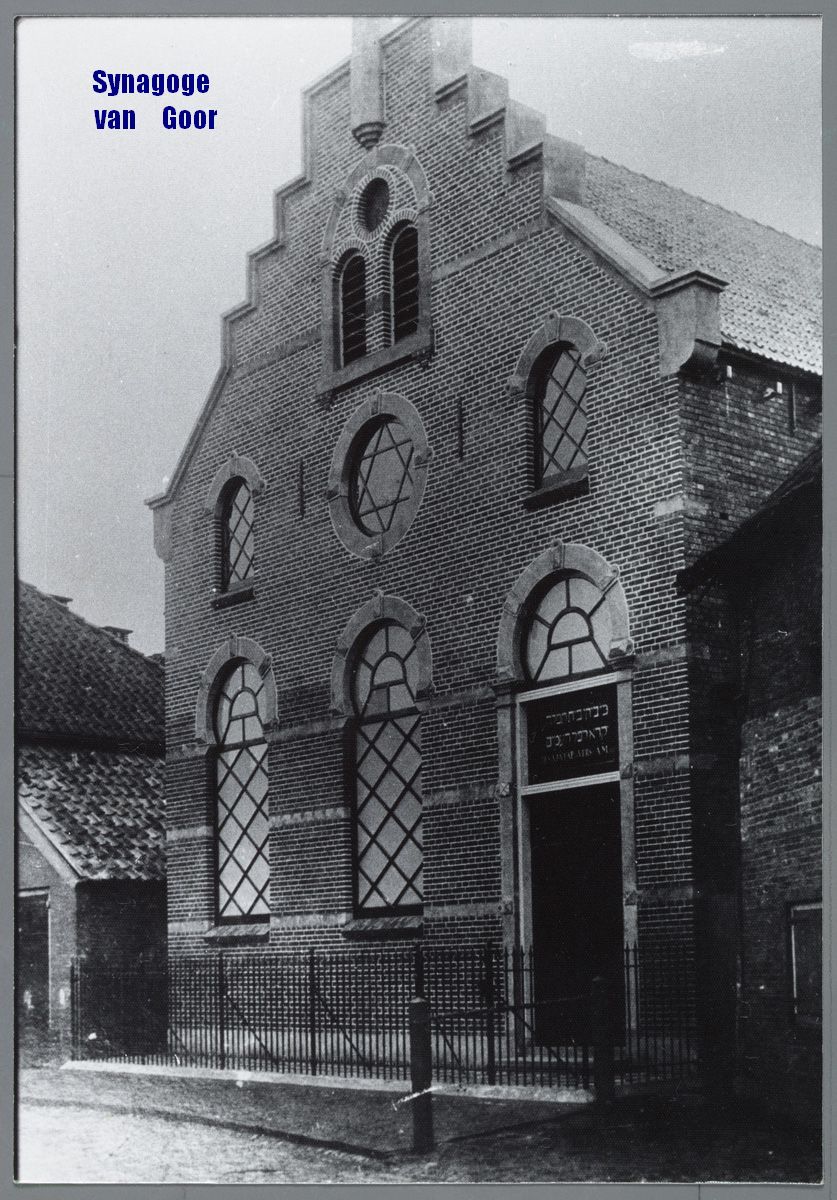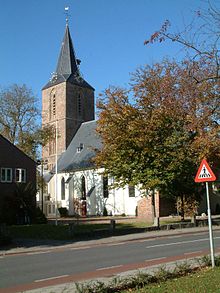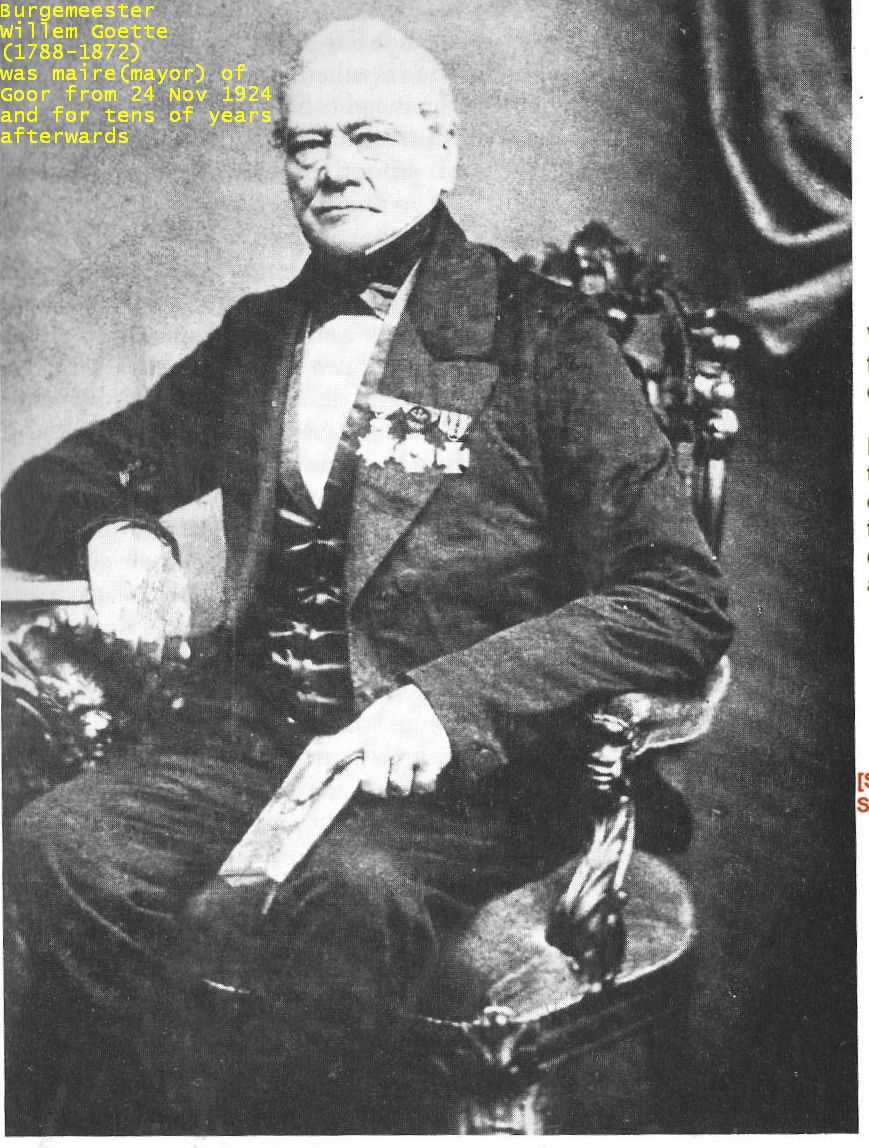The Jewish community of Goor as from 1900
Sources:
M.A. Sloot, Sprokkelen in Goors verleden.
Stichting Goors Historie 1987, pages 112-129, edited by H.H.G. de
Jong
A short historical summary
The first Jewish family names in Goor appear in the accounts of the
Drost of Twente covering the period of 1336-1339. In
1336 the property of six Jewish families from Oldenzaal,
Goor and Diepenheim was confiscated.
The Jews were accused of causing the black plague epidemic
(1347-1351) by poisoning the water wells. As a result
many Jews were killed or expelled.
In 1390 a Jewish inhabitant of Goor is mentioned in the Town
Protocol, Herman the Jode, counselor of the town.
In 1546 Karel V issued a decree expelling the Jews of Utrecht and
probably also of Oversticht (Overijsel).
In 1679 Hijman Jacobs and in 1698 the butcher Moses Salomon
requested permission to live in Goor. Placards from
those years order the Jews to return to their place of
living. In 1739 the States of Overijsel decreed that
foreign Jews were not permitted to settle in Overijsel.
Nevertheless the stream of immigrants from Eastern Europe did not
stop.
According to the Nieuw Israelitisch Weekblad, the number of Jews
living in Goor in 1914 was 96; before the second world
war there were 32. Directly after the war 19 were left.
Family names
We shall discuss the following family names: Brogholter, Fortuin,
Hoek, van Messel, Polak, Herschel, van Engel, Asser,
Muller, Mogendorff, Vecht, Cracau, Mendels, Kwitser,
Lobstein, Kan, Salomonson, Siwowicz, Stern, ten Brink,
Wolff, Spanjer.
Nathan Brogholter.
Nathan Brogholter, and his brother traded in knitting and sewing
machines. One brother was the seller and the other the
cashier.
Moses Jacob Fortuin.
Moses Jacob Fortuin, married Kaatje Niekerk. He owned a trade in
sewing requisites. He moved to Lochem, where he
established a small yarn factory. In 1919 he moved to
Deventer.
Andries Hoek.
Andries Hoek (1842-1925), married Dina Prins (1846-1891). Their son,
Ezechiel Jacob (1875-1968) married Catharina Gosschalk
(1874-1964). He had a drapery shop and also traded in
gold and silver. He was a city councilor from 1923 till
1927. In 1901 he founded the gymnastics club Excelsior.
He was in hiding in Stokkum and survived WWII.
The couple had four children: David, died from cancer, Andries,
moved to Lochem, Dina Stella, who died in hiding in 1944
and was buried in the garden of the family who had
hidden her and Izak Jacob (1906-1984), nicknamed Broer.
Izak was married to Roza From (born 1912); the couple had three
children Edu, Selma Catharina and Duco. Edu managed the
family enterprise, which concentrated on internal
architecture.
Van Messel.
Van Messel, gravedigger and "shammesj", married
Eefje Polak.
Two sons: Israel (teacher) and Eduard (butcher).
The family Polak was a large family.
Hartog Polak, born 1847, nicknamed "de Plakke" was married twice.
First marriage with Dina Engers, with four children: Roosje, Betje
(1887), Levie and Israel (1879). All moved to Germany.
Second marriage with Esther de Levie (1863), six children: Sally
(1898), Marcus (1903), Bram (1896), Heiman (1894), Simon
(1900-1926) and Sara (1907).
Marcus was mentioned in the news in 1929, because he was knifed by a
German, whom he tried to help. The German attacker was
returned to Germany and Marcus did not receive any
compensation. His hospitalization was paid for by the
Hengelo municipality.
Bram was married to Hedwig Cohen (1898). They had two children:
Harry Simon and Johnny Magnus.
Sally married Aaltje Bakker; they had one son named Hartog.
In 1943 Esther was transported in an ambulance to Westerbork.
Heiman, Marcus and the little Johnny Magnus died in
Mauthausen and Sobibor. Bram also died during the war,
location unknown.
Mozes Herschel, goat butcher.
Rabbi Wolf.
Rabbi Wolf, nicknamed the "Jodenmeester," was the Jewish teacher.
He had one daughter, Roosje.
Family van Engel
Mozes van Engel had three sons and six daughters:
Son Daniel
Son Nathan
Son Aron
Daughter Bertha
Daughter Sara
Daughter Miete
Daughter Dientje
Daughter Sientje
Daughter Bet
Son Daniel (1857-1909), a butcher, married three times:
1.
First marriage
with Francisca Gruenewald (1869-1895), two sons: Nats
(1889), a teacher and Mozes Aron (1888).
2.
Second marriage
with … Frank, one son Salomon.
3.
Third marriage
with Johanna Gruenewald (1869-1943), three children: Ies
(1903), Joeltsje (1896-1920) and Emma, who migrated to
the USA.
Johanna was hidden during the war in
Holten, was betrayed and died in Sobibor. Ies was
arrested during a great razzia in Twente in 1941 and
died in Mauthausen.
Son Nathan (1863-1932), married Hanchen Bendix, they had two
daughters and five sons.
Two daughters: Roza (1900-1943) and Heintje.
Five sons: Leo, Daniel, Marcus, Benjamin, Mozes.
Mozes died in 1935. His wife and daughter Sonja were hidden during
the war for two years and survived.
Son Aron married to Sara Bendix, two children: Mozes and Mathilda.
Daughter Bertha, married Lobstein.
Daughter Sarah, married
Boekbinder, daughter Rebecca
Daughter Miete, married Elzas, eight children.
Daughter Dientje, married Serphos, three children.
Daughter Sientje, married Muller.
Daughter Bet, married Herschel, ten children.
Altogether father Mozes had nine children and about forty
grandchildren.
Only Sonja, a granddaughter of Bet, and Emma a daughter of Nats
survived WW II.
The Mullers.
The four Muller brothers founded a butter factory in 1879. The
founders were: Asser and Lion, nicknamed the
"Botterjoerre", from Goor and Salomon and Wolf from
Oldenzaal. They also traded in margarine and ham.
Asser had three sons. Charles, nicknamed the "Groot'n Botterjoerre,"
Louis nicknamed the "Klein'n Botterjoerre," and Bernard.
All three moved to The Hague.
Lion also had three children. Emma, Heintje and Moewke. Heintje
published a book on her family, and Moewke became a
gynecologist. He was arrested and interned in Barneveld,
where he died. He wrote a book "Memories of a
gynecologist," published after his death by Bruna in
1948.
J. Mogendorff.
Mogendorff traded in antiques, gold, silver and umbrellas. Later on
he appeared at fairs with a puppet show. He had four
children: Bertha, Sara, Leo, who had an antiquity shop
in London, and Ies, a manufacturer in Amsterdam.
Salomon Vecht.
Salomon Vecht (1862) married Rozette Hoek (1849). He
was
a cattle trader. Their son David traded in gold and
silver and due to an administrational error he was
transported during the war to a concentration camp, as
described in the book:
"Attorny at law during occupation" by Benno Stokvis.
Cracau.
Abraham Jozef Cracau, nicknamed "Beret Cracau", traded in hats and
handkerchiefs. After his store was burnt, he opened a
market stand in Amsterdam.
Salomon Jozef Cracau, the "Paper Cracau", traded in writing
accessories and lottery letters. He was married to a
rich woman, Froneque Ganz.
L. Mendels.
L. Mendels, owner of a bookshop, married Emma Salomons.
The couple moved to Almelo.
L. Kwitser (1866-1945).
L. Kwitser was a Physician, who settled in Goor in1909. He also was
a good marksman, and a member of the "Koningin Emma
Association."
He married Estella Josephine Levie (1873-1941).
Two daughters: Marie Anne (1900) and Louisa Emma.
He went into hiding in 1943 and died on 19 January 1945.
J. Lobstein.
Jacques Lobstein married Betje van Engel
(1851), Nathan van Engel's sister.
They had 5
children. Their son Bram, who sold charcoal, was well
known in Goor. He was a council member from 1909 till
1931.
He had two sons, Herman – born in 1914, who committed suicide in
1940 after the German invasion – and Jacques, an
attorney at law, married to Eva Berlijn. They had no
children. Jacques was in hiding during the war and
survived.
Bram had three brothers and one sister: Hein, an officer in the
Dutch army, Lex and Bennie, both teachers and Reina,
their sister.
Hein was nicknamed Orange Hein, because he used to wave an orange
flag so as to to tease his brother Bram, who was called
the Red Bram, due to his socialist inclination.
From 1909 till 1939 Hein was a council member for the SDAP, but in
1926 he quarreled with his own party members. He
actually wanted to become the burgomaster. Finally he
founded a party of his own, the "Independent Party," and
from 1927 he formed the opposition in the town council.
De Beer.
De Beer, a butcher, married de Jong, two daughters: Fini, married to
Katz and Jeanette married to Levis.
A family named Rozendaal.
The mother: Jette. The children: Leo, Lena and Ies.
Leo was married to Julia Frankenhuis.
Lena and Ies went into hiding during the war, but were arrested and
died in a concentration camp.
N. Kan, peddler in cloth. His son, Ies, was married to Julia
Meijers, a hatmaker.
Salomonson, was a butcher of sheep, goats and cattle.
Rabbi Enoch Siwowicz was born in 1878. He came to Goor in 1933 and
died there in 1934. He lived in rooms rented from Moos
van Engel.
A family named Stern.
This family arrived in Goor in 1936. Erich Stern, together with
butcher Loewenhardt and dentist Kahn started a factory
for the producing of fat, which was closed after two
years.
The Stern couple had two daughters; one of them was Eefje
(1938-1984). They and both their daughters went into
hiding and survived the war.
Loewenhardt and Kahn did not survive.
In 1938 Werner ten Brink settled in Goor, with his parents. His
father, Herman ten Brink (1888-1965), was born in the
Netherlands, and his mother, Sophie Lehman (1887-1960),
came from Germany.
During the war the whole family went into hiding and survived.
Michael Wolff and his wife Felicia van Lier settled in Goor in 1934.
They had one daughter, Ruth Flora Rosalie. Michael Wolff
was an attorney at law and an Inspector Accountant of
the "Joodse Raad."
The couple was arrested in 1941 and died in Auschwitz. Their
daughter survived the war.
Sallie Spanjer (1898-1957). In 1924 Sallie was appointed chief
inspector of the abattoir at Goor, and moved to Goor
with his wife and daughter Selma. The three of them were
hidden during the war and survived.
After the war Sallie was the secretary of the Jewish community and
was responsible for the sale of the synagogue.
Jewish victims 1940-1945
|
Name |
Date of birth |
Removed from the civil registry in Goor |
Died |
|
Michael Wolff |
09.03.1904 |
03.10.1941 |
27.08.1943 Auschwitz |
|
Felicia Wolff-van Lier |
13.11.1902 |
03.10.1941 |
27.08.1943 Auschwitz |
|
Leonard Rozendaal |
18.11.1918 |
25/11.1942 |
16.03.1943 Bobzek |
|
Julia R. Frankenhuis |
25.03.1917 |
11.12.1942 |
Auschwitz |
|
Israel Ies Rozendaal |
28.06.1911 |
11.12.1942 |
31.03.1944 |
|
Jette Rozendaal v. Wije |
17.10.1879 |
11.12.1942 |
21.05.1943 Sobibor |
|
Heiman Polak |
28.10.1884 |
|
07.10.1941 Mauthausen |
|
Marcus Polak |
22.04.1903 |
|
31.05.1945 Bergen Belsen |
|
Abraham Polak |
08.09.1896 |
|
31.03.1944 |
|
Johny Magnus Polak |
17.04.1935 |
|
11.06.1943 Sobibor |
|
Saartje Polak de Beer |
02.02.1863 |
|
23.04.1943 Sobibor |
|
Wed. E. Polak de Levie |
02.02.1863 |
|
23.04.1943 Sobibor |
|
Isidor Ies van Engel |
09.10.1903 |
|
10.10.1941 Mauthausen |
|
Johanna v. Engel –Gruenewald |
15.02.1869
|
|
14.05.1943 Sobibor |
|
David Vecht |
17.09.1888 |
|
22.10.1943 Auschwitz |
|
Herman Lobstein |
21.09.1914 |
Zelfmoord |
14.05.1940 |
The old synagogue.
According to the land register there already was a synagogue in Goor
in 1870. On a ground plan from the year 1883 the
synagogue is marked between a café and a school
building. In the town plan mention is made of a church
and a courtyard (1884), church, bathroom and courtyard
(1890), synagogue, school, bathroom and courtyard
(1894).
According to a deed from 1895 the synagogue council, composed of
Messrs. Brogholter, Lion Liefman Muller, Israel de Beer,
Abraham Cracau, and Salomon Vecht, acquired a parcel of
land behind the synagogue.
In 1898 Nathan van Engel acquires- in name of the Jewish community
of Goor- a house with a garden where the new synagogue
will be erected. From 1902 till 1946 this synagogue was
situated in the Schoolstraat (formerly Malmberg).
During the German occupation the synagogue was emptied by the
Germans. The seats and all the woodwork were demolished.
In March 1945 the building was heavily damaged during a
bombardment.
In July the building was sold for over one million guilders.
The inventory of the synagogue was as follows:
|
|
|
Value in guilders |
|
4 |
Benches, 3 seats |
364 |
|
2 |
Benches, 4 seats |
56 |
|
1 |
Bench, 2 seats |
15 |
|
1 |
Bima |
127 |
|
1 |
Aron Kodesh |
65 |
|
4 |
Velvet curtains |
600 |
|
2 |
Handforged copper crowns, with 16 lightpoints |
400 |
|
4 |
Handforged copper candelabras |
140 |
|
1 |
Stove with pipes |
70 |
|
|
Silver ornaments |
200 |
|
1 |
Large cupboard |
100 |
|
1 |
Small cupboard |
55 |
|
1 |
Blackboard |
75 |
|
10 |
School benches |
280 |
|
|
Total |
2547
|
Documents from the Nederlands Israelitisch Kerkgenootscap in
Amsterdam, prove that four torah rolls and silver
ornaments were deposited with the Twentse Bank Goor,
which handed these items over to the German invaders.
Probably the NSB, the Dutch Nazi Party, which cooperated with the
Germans, put their hands on these items, but this
possibility cannot be proved. Anyway, after the war they
were regarded as lost, and are not included in the above
inventory.
The Jewish cemetery
According to the land register the cemetery was situated in the
Molenstraat, to be reached by a path between Molenstraat
12 and 14. The oldest stone found, dating from 1679,
bears the name of Heiman Jacobs. The nowadays cemetery,
which must have been established in 1720, on an area of
2402 square meters, has been recognized as an official
monument, and is being maintained by the Goor
municipality.
On the left side of the main path there are 10 tombstones and 46 on
the right. Some texts are in Hebrew.
The following tombstones are legible:
Kaatje Niekerk widow of Mozes Jacob Fortuin
1881-1964
Hartog Lievendag, husband of Grietje Fortuin
1906-1963
Ezechiel Jacob
Hoek, widower of Catharina Gosschalk
1875-1963
Catharina Gosschalk
1874-1964
Herman ten Brink, en zijn vrouw
1888-1965
Sophie Lehmann
1887-1960
Roza ten Brink-van Zuiden
1918-1963
Sallie Spanjer en zijn vrouw
1898-1952
Grietje Frankenhuis
1898-1957
Henriette Spanjar-Cohen
1895-1927
Erich Stern
1906-1971
Bets Cohen, weduwe van Mozes van Engel
Mozes van Engel
1885-1936
Jacob Hoek, oud 89 jaar
Doortje Hoek, oud 77 jaar
Mozes van Engel
1818-1916
Julia van Engel, oud 23 jaar
1897-1920
Andries Hoek, weduwnaar van Diane Prins
1848-1925
Leo van Engel
1929
Hanchen Bendix, weduwe van Nathan van Engel
1859-1940
Nathan van Engel
1843-1932
Simon Siwowicz
1887-1934
Julia Kan-Meijers
1874-1953
Josephus Hermanus de Vries
1799-1857
Betje Samuel
1796-1869
Extracted from source (in Dutch) by:- H.H.G. de Jong-(Rhenen)
Translated from Dutch by Michael Jamenfeld
Review:-Ben Noach
End editing:-Hanneke Noach
Search All genealogy family trees / Northern
province database / Ashkenazi Amsterdam database / The Nijmegen
family trees / The regional family trees /The whole
website
REMARK:- Please note that the search results
give all instances where the requested search string figures in
the databases.So not only the name of the location, but also
persons, that bear the name of the town or the village, are
included in the results returned.



View Larger Map